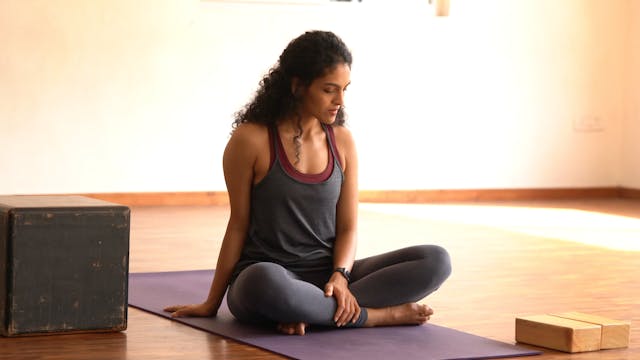Shiro bheda Shloka
Playlist 17 : Repertoire Pushpanjali
•
1m 0s
The head is considered one of the Angas, or major limbs according to the Natyashastra.
The movements of the head are used not only for the precise control in the execution of Nritta but also to communicate meaning in the context of gesture.
Please refer to the Shloka below for pronunciation. Please note that the separate movements of the head when put together in a Shloka form 'Sandhis', or compound words in the Sanskrit language. Words like 'ca', 'thatha', mean "and", "also". The separate words for each movement are also given below the shloka.
Ākampitam Kampitam ca dhutam vidhutameva ca
Parivāhitodvāhitakamavadhutam tathāñcitam
Nihañcitam parāvrttamutkshiptam cāpyadhogatam
Lolitam caiva vijñeyam trayodaśacidham Śirah
Ākampita
Kampita
Dhuta
Vidhuta
Parivāhita
Udvāhita
Avadhuta
Añcita
Nihañcita
Parāvrtta
Utkshipta
Adhogata
Lolita or Parilolita
Up Next in Playlist 17 : Repertoire Pushpanjali
-
Hip Openers
This series can be practiced after a basic warm up, before beginning an Adavu practice.
The hip opener series will help you navigate through tight hips. It will help you mobilise your hips and enable you to push your thighs back while sitting in Araimandi. Please do this in combination with str...
-
Legs and core 1
The first Strength regimen concentrates on two primary areas. The core and the legs. These two areas are necessary to move efficiently in a Bharatanatyam practice. The stabilisation of core muscles is necessary to move safely when dancing. This protects our back and helps with speed and clarity. ...
-
Flexibility: Shoulders & Arms
Mobility and flexibility in the arms is necessary for efficient movement to happen. When there is tightness around the arms, the movement may look restricted when dancing and you will not have proper alignment because of tightness. This video helps promote mobility in the arms and can be done alo...


